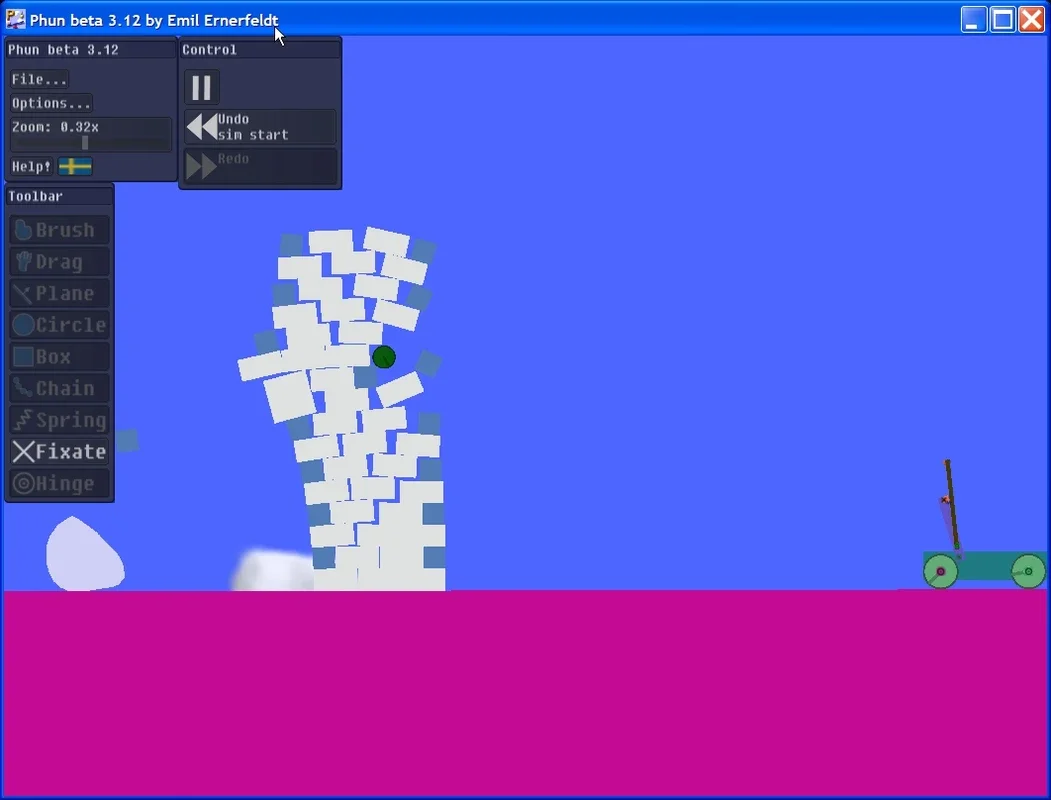Phun App Introduction
Phun is a unique physics sandbox game that lets you experience the laws of physics in a playful and creative way. Unlike traditional games with pre-defined levels and objectives, Phun empowers you to build your own interactive worlds using simple shapes and tools. This article delves into the core mechanics, features, and overall experience of Phun, highlighting its enduring appeal and comparing it to similar physics-based simulation software.
Core Mechanics: Building with Physics
At its heart, Phun is a physics engine. You start by drawing simple shapes – circles, rectangles, and squares – and then watch as they interact realistically with each other and the environment. Gravity, acceleration, and momentum are all simulated, allowing for complex and often unpredictable interactions. The simplicity of the drawing interface belies the depth of the physics simulation, making it accessible to beginners while still offering a rich playground for experienced users.
The core mechanics are surprisingly intuitive. You draw a shape, and Phun instantly calculates its properties and incorporates it into the simulation. You can then manipulate these shapes, adding forces, constraints, and other elements to create intricate contraptions and machines. The lack of complex menus or controls keeps the focus on experimentation and play.
Key Features and Tools
Beyond the basic shapes, Phun provides a few essential tools to enhance your creations:
- Finge: A rotatory engine controlled using the arrow keys, allowing for the creation of moving parts and mechanisms.
- Fixate: A tool to fix elements in place, preventing them from moving or rotating. This is crucial for building stable structures and complex machines.
- Spring: A classic spring element that adds elasticity and dynamic interaction between objects.
These simple tools, combined with the physics engine, allow for a surprising level of complexity. You can build simple machines, complex contraptions, or even just watch objects interact in chaotic and entertaining ways.
Templates and Inspiration
For those who need a little inspiration, Phun offers a range of pre-built templates. These templates showcase the possibilities of the game, providing examples of complex machines and contraptions that you can study, modify, and use as a starting point for your own creations. This is particularly helpful for beginners who are still learning the ropes of the physics engine.
Comparing Phun to Other Physics Engines
While Phun might seem simple at first glance, its unique approach to physics simulation sets it apart from other similar software. Compared to more complex physics engines like Algodoo or Box2D, Phun prioritizes ease of use and intuitive interaction. While it lacks the fine-grained control and advanced features of these alternatives, its simplicity makes it incredibly accessible and fun for a wider audience.
Unlike more specialized software focused on engineering or scientific simulations, Phun is purely focused on entertainment and creative exploration. It's a game, not a tool, and this focus on fun is what makes it stand out. The lack of complex menus and the intuitive drawing interface make it a joy to use, regardless of your technical expertise.
Phun's Enduring Appeal
Despite its age, Phun continues to hold a special place in the hearts of many physics enthusiasts and casual gamers alike. Its simple yet powerful mechanics, combined with its intuitive interface, create a truly unique and engaging experience. The freedom to experiment and create without limitations is a key part of its appeal, allowing for endless hours of fun and exploration.
The game's enduring popularity is a testament to its simple yet effective design. It's a testament to the power of intuitive design and the enduring appeal of simple, yet effective, physics-based gameplay. Phun's legacy lies in its ability to make complex physics concepts accessible and fun for everyone, regardless of their background or technical skills.
Beyond the Basics: Advanced Techniques
While Phun's core mechanics are straightforward, mastering the nuances of the physics engine requires practice and experimentation. Understanding how different shapes interact, how forces are applied, and how to use the tools effectively is key to creating truly impressive and complex machines. Experienced users can create intricate contraptions that defy expectations, showcasing the depth and complexity hidden beneath the game's simple interface.
The ability to combine different elements and tools in unexpected ways allows for a high degree of creativity and experimentation. There's no right or wrong way to play Phun; the only limit is your imagination. This open-ended nature is a key part of the game's enduring appeal, encouraging players to explore, experiment, and discover new and unexpected ways to interact with the physics engine.
Phun for Windows: A Timeless Classic
Phun's availability on Windows makes it accessible to a large audience. The Windows version retains all the core features and mechanics of the original game, providing a seamless and enjoyable experience for users of this popular operating system. The ease of use and intuitive interface make it a perfect choice for both casual gamers and physics enthusiasts alike.
The Windows version of Phun is a testament to the game's enduring appeal and its ability to transcend platform limitations. It's a classic physics sandbox game that continues to provide hours of entertainment and creative exploration for users of all skill levels.
Conclusion: A Physics Playground for Everyone
Phun is more than just a game; it's a physics playground. Its simple interface and powerful physics engine make it accessible to everyone, regardless of their technical skills. Whether you're a physics enthusiast, a casual gamer, or simply someone who enjoys creative experimentation, Phun offers a unique and rewarding experience. Its enduring popularity is a testament to its simple yet effective design and its ability to spark creativity and imagination.
